Glossary
Plant Care Library
J
Jaboticaba Sabara Bonsai
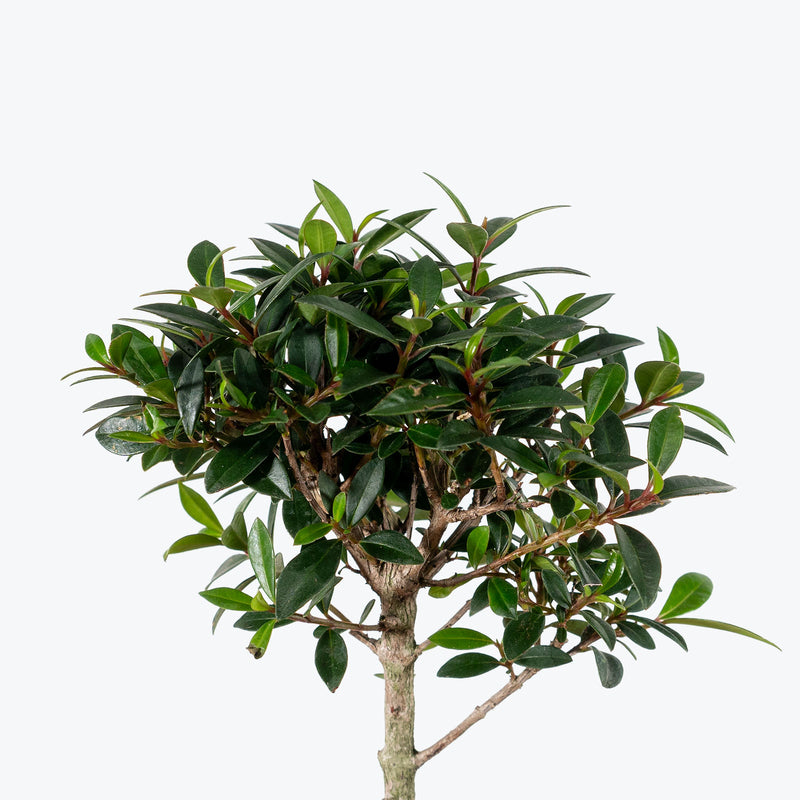
How to care for Jaboticaba Sabara Bonsai
Jaboticaba Sabara Bonsai enjoys some direct sun, but they'll also do well in bright, indirect light. It is best to place this plant somewhere where it will receive some nice morning sun, or a couple hours of afternoon sun, and then indirect light the rest of the day.
Jaboticaba Sabara Bonsai will do best in bright light. A nice bright place inside your home would be on the window sill or a stool that is right next to a window, either with or without blinds, depending on if the plant can handle sun. Remember that plants will grow based on how much light they receive.
Allow the top quarter of the soil to dry before watering Jaboticaba Sabara Bonsai again. This usually takes about 3 - 4 days in an average home environment. It will vary depending on the time of year, your environment and lighting conditions. Expect to water more often in brighter light and less often in lower light.
Jaboticaba Sabara Bonsai likes a high humidity environment, give them a mist daily or as often as possible. Alternatively, you can put them around a humidifier. Although they won't die if they don't receive enough humidity, their leaves may have some dry, crunchy, or yellow edges.
Fertilize your Jaboticaba Sabara bonsai every month during the growing season with a balanced, liquid fertilizer, reducing to every other month in the winter. Pruning and shaping can be done to maintain its miniature stature and desired form. The tree can flower and fruit multiple times a year if its environmental conditions are met, especially after a period of stressing, such as slight root pruning or drought stress followed by generous watering.
You can feel comfortable having Jaboticaba Sabara Bonsai around your home in the potential case where your pet feels like nibbling on it. However, we typically recommend keeping your pets from eating any of your houseplants..
View PlantJade Coral
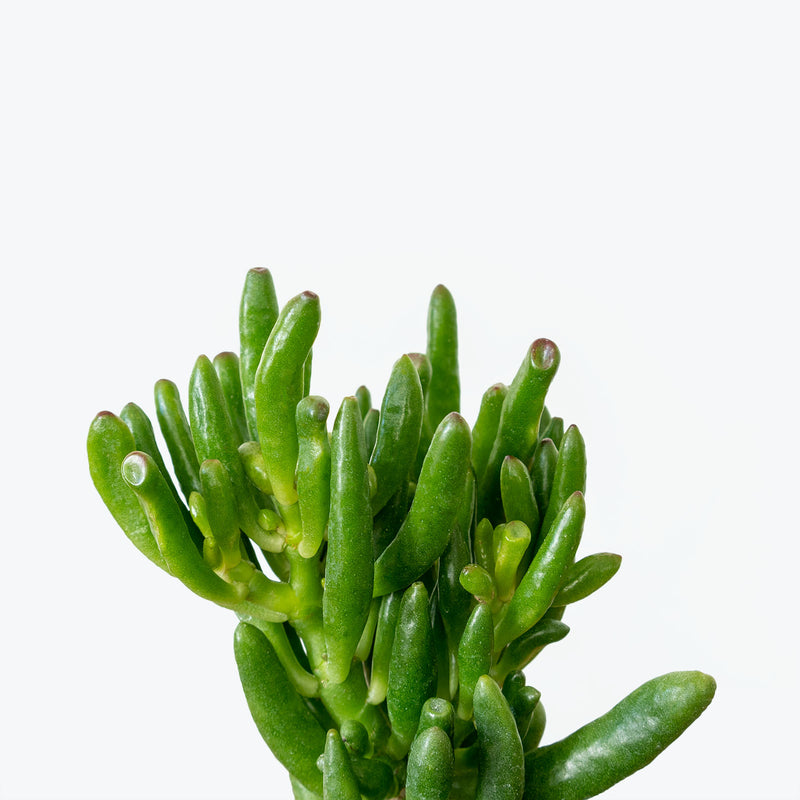
How to care for Jade Coral
Jade Coral enjoys direct sun, but they'll also do well in bright, indirect light. It is best to place this plant somewhere where it will receive some nice morning sun, or a couple hours of afternoon sun, and then indirect light the rest of the day.
Jade Coral will do best in bright light. A nice bright place inside your home would be on the window sill or a stool that is right next to a window, either with or without blinds, depending on if the plant can handle sun. Remember that plants will grow based on how much light they receive.
Jade Coral likes the soil to be completely dry before the next watering. That usually takes about 4 weeks in an average home environment. It will vary depending on the time of year, your environment and lighting conditions, but for them, it's always safer to underwater or water when you see signs of lack of water (i.e. wrinkly or soft leaves). Water a little more often in the warmer months.
Jade Coral can live in any average home humidity condition and are fairly hardy.
As with all succulents, overwatering is sure to be fatal, so err on the side of too dry rather than too wet. Never let your Jade Coral plant sit in water. If you are training your jade to go in full sun, make environmental changes gradually so as not to burn the leaves. Repotting is only necessary every few years to refresh the soil or if the plant has outgrown its container.
Jade Coral is moderately toxic and can cause some adverse reactions when ingested so it is best to not let your pets eat it, which we advise for all plants in general. The severity of the reaction will depend on how much of the plant is ingested but, if you know your pet typically does not eat your plants, this plant will be suitable for your home..
View PlantJade Hobbit
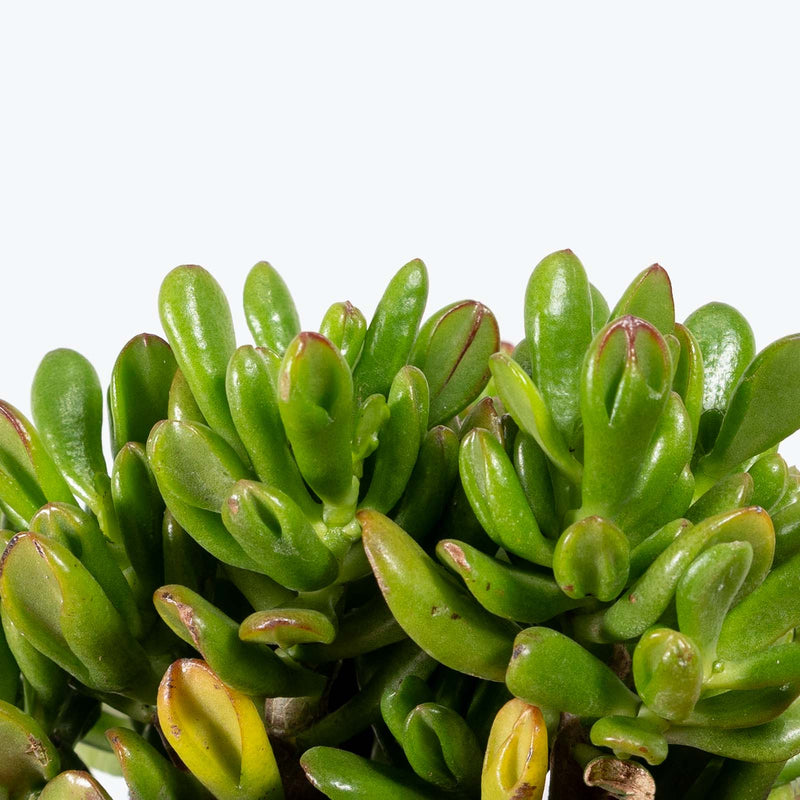
How to care for Jade Hobbit
Jade Hobbit enjoys direct sun, but they'll also do well in bright, indirect light. It is best to place this plant somewhere where it will receive some nice morning sun, or a couple hours of afternoon sun, and then indirect light the rest of the day.
Jade Hobbit will do best in bright light. A nice bright place inside your home would be on the window sill or a stool that is right next to a window, either with or without blinds, depending on if the plant can handle sun. Remember that plants will grow based on how much light they receive.
Jade Hobbit likes the soil to be completely dry before the next watering. That usually takes about 4 weeks in an average home environment. It will vary depending on the time of year, your environment and lighting conditions, but for them, it's always safer to underwater or water when you see signs of lack of water (i.e. wrinkly or soft leaves). Water a little more often in the warmer months.
Jade Hobbit can live in any average home humidity condition and are fairly hardy.
As with all succulents, overwatering is sure to be fatal, so err on the side of too dry rather than too wet. Never let your Jade Hobbit plant sit in water. If you are training your jade to go in full sun, make environmental changes gradually so as not to burn the leaves. Repotting is only necessary every few years to refresh the soil or if the plant has outgrown its container.
Jade Hobbit is moderately toxic and can cause some adverse reactions when ingested so it is best to not let your pets eat it, which we advise for all plants in general. The severity of the reaction will depend on how much of the plant is ingested but, if you know your pet typically does not eat your plants, this plant will be suitable for your home..
View PlantJade Plant
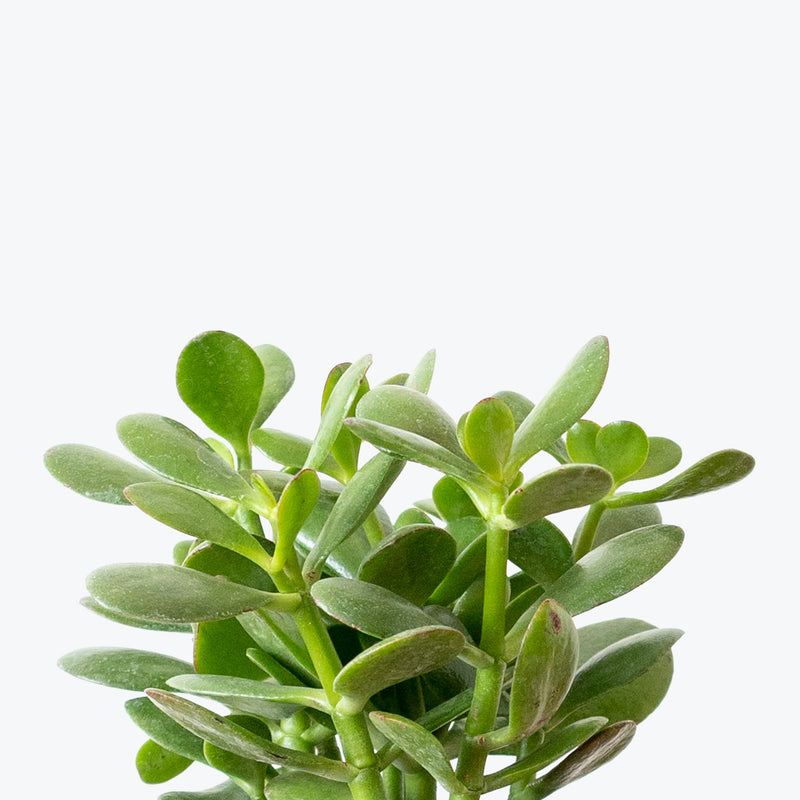
How to care for Jade Plant
Jade Plant enjoys some direct sun, but they'll also do well in bright, indirect light. It is best to place this plant somewhere where it will receive some nice morning sun, or a couple hours of afternoon sun, and then indirect light the rest of the day.
Jade Plant will do best in bright light. A nice bright place inside your home would be on the window sill or a stool that is right next to a window, either with or without blinds, depending on if the plant can handle sun. Remember that plants will grow based on how much light they receive.
Jade Plant likes the soil to be completely dry before the next watering. That usually takes about 4 weeks in an average home environment. It will vary depending on the time of year, your environment and lighting conditions, but for them, it's always safer to underwater or water when you see signs of lack of water (i.e. wrinkly or soft leaves). Water a little more often in the warmer months.
Jade Plant can live in any average home humidity condition and are fairly hardy.
As with all succulents, overwatering is sure to be fatal, so err on the side of too dry rather than too wet. Never let your jade plant sit in water. If you are training your jade to go in full sun, make environmental changes gradually so as not to burn the leaves. Regular pruning can help maintain its shape and encourage more robust growth. Repotting every few years in spring or early summer can refresh its soil and provide room for growth.
Jade Plant is moderately toxic and can cause some adverse reactions when ingested so it is best to not let your pets eat it, which we advise for all plants in general. The severity of the reaction will depend on how much of the plant is ingested but, if you know your pet typically does not eat your plants, this plant will be suitable for your home..
View PlantJade Plant Variegated
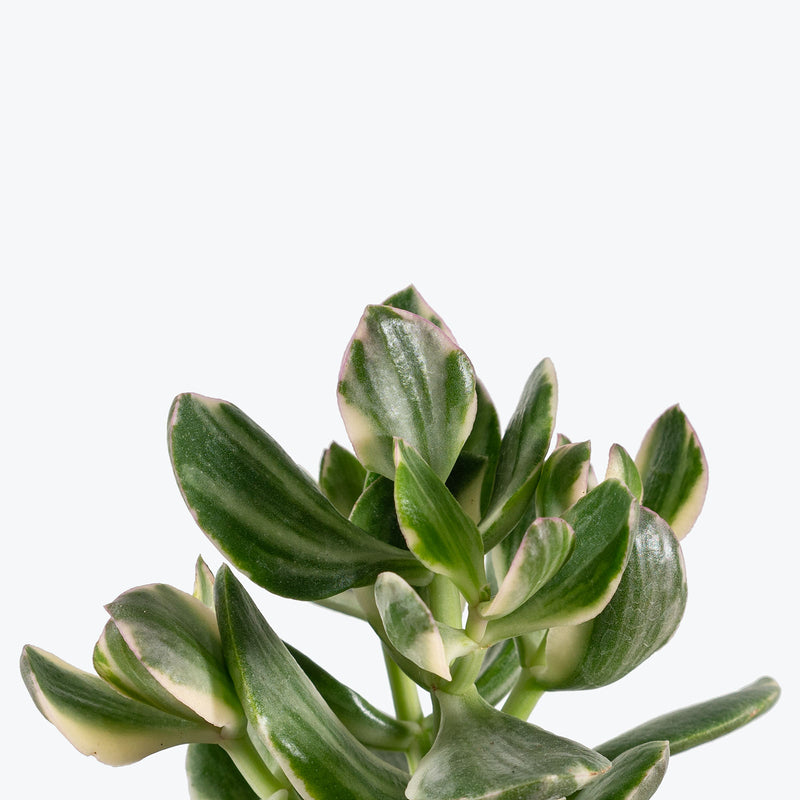
How to care for Jade Plant Variegated
Jade Plant Variegated enjoys some direct sun, but they'll also do well in bright, indirect light. It is best to place this plant somewhere where it will receive some nice morning sun, or a couple hours of afternoon sun, and then indirect light the rest of the day.
Jade Plant Variegated will do best in bright light. A nice bright place inside your home would be on the window sill or a stool that is right next to a window, either with or without blinds, depending on if the plant can handle sun. Remember that plants will grow based on how much light they receive.
Jade Plant Variegated likes the soil to be completely dry before the next watering. This can take up to 4 weeks in an average home environment but it will vary depending on the time of year, your environment and lighting conditions. For them, it's always safer to underwater or water when you see signs of lack of water (i.e. wrinkly or soft leaves). Water a little more often in the warmer months.
Jade Plant Variegated can live in any average home humidity condition and are fairly hardy.
As with all succulents, overwatering is sure to be fatal, so err on the side of too dry rather than too wet. Never let your Jade Plant Variegated sit in water. If you are training your jade to go in full sun, make environmental changes gradually so as not to burn the leaves.
Jade Plant Variegated is moderately toxic and can cause some adverse reactions when ingested so it is best to not let your pets eat it, which we advise for all plants in general. The severity of the reaction will depend on how much of the plant is ingested but, if you know your pet typically does not eat your plants, this plant will be suitable for your home..
View PlantJasmine Sambac
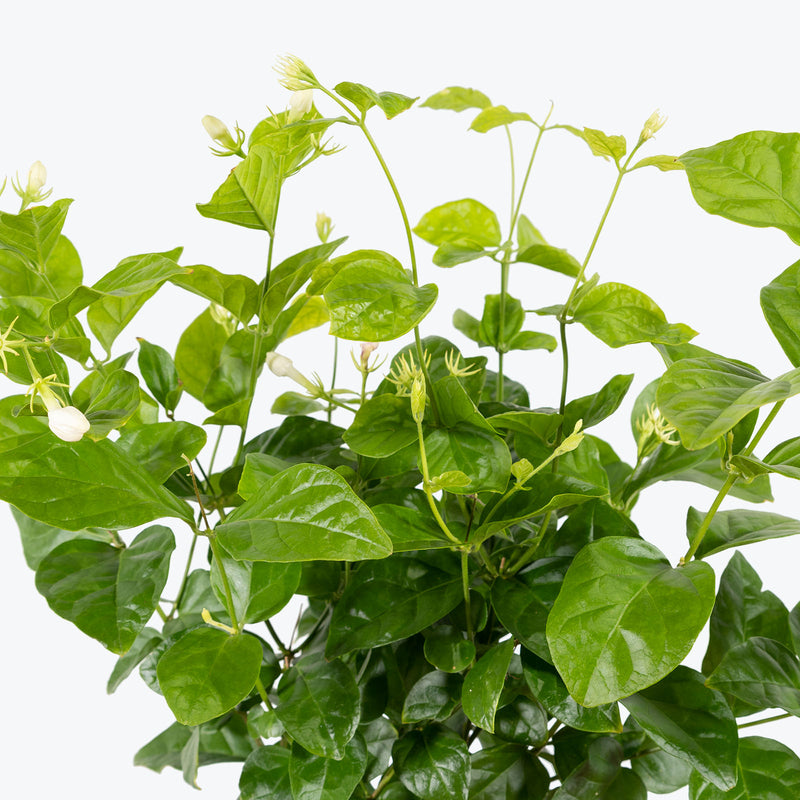
How to care for Jasmine Sambac
Jasmine Sambac enjoys some direct sun, but they'll also do well in bright, indirect light. It is best to place this plant somewhere where it will receive some nice morning sun, or a couple hours of afternoon sun, and then indirect light the rest of the day.
Jasmine Sambac will do best in bright light. A nice bright place inside your home would be on the window sill or a stool that is right next to a window, either with or without blinds, depending on if the plant can handle sun. Remember that plants will grow based on how much light they receive.
Jasmine Sambac needs to be watered when the top half of the soil is dry to the touch. That usually takes about 1 week in an average home environment. It will vary depending on the time of year, your environment and lighting conditions, but it's always safer to underwater or give the soil a check before you water again. Expect to water more often in brighter light and less often in lower light.
Jasmine Sambac likes a high humidity environment, give them a mist daily or as often as possible. Alternatively, you can put them around a humidifier. Although they won't die if they don't receive enough humidity, their leaves may have some dry, crunchy, or yellow edges.
Since Jasmine Sambac grows rapidly, pruning will be necessary to keep the plant in shape, encourage branching, and help bloom. The best time to do so would be late spring and mid summer, pruning about half an inch back. Jasmine Sambac plants drop leaves, or they dry up, from both too much and too little water, so make sure you are watering accordingly. They will also tend to drop their buds after going through an environmental change, so try to keep their care very stable. Keep them away from drafts and dry air, but make sure they are not kept too warm, as high temperatures will encourage growth but not bloom production.
You can feel comfortable having Jasmine Sambac around your home in the potential case where your pet feels like nibbling on it. However, we typically recommend keeping your pets from eating any of your houseplants..
View PlantJewel Orchid
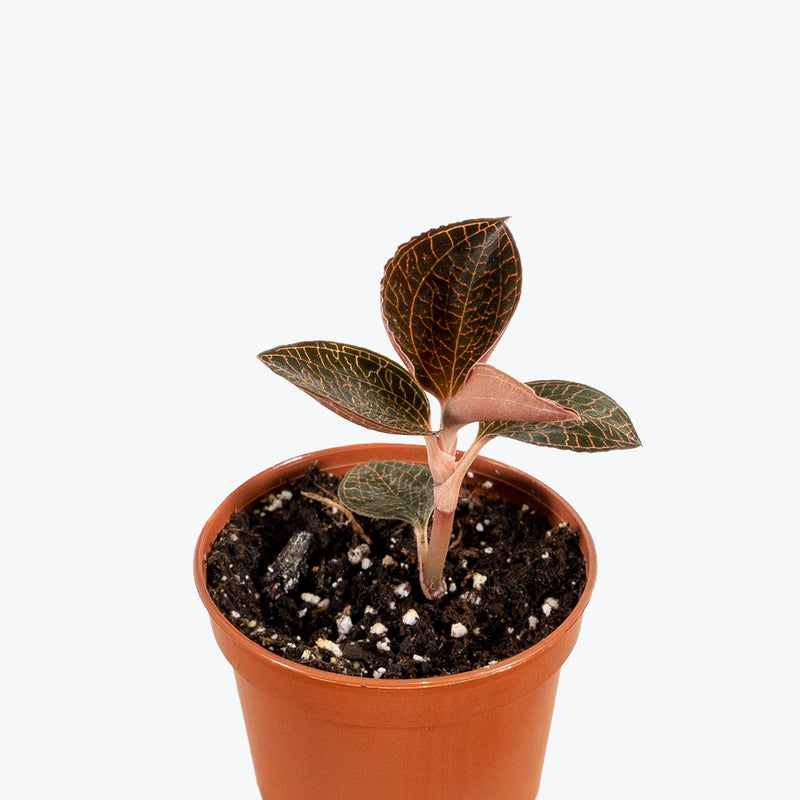
How to care for Jewel Orchid
They should not be in a position to see the sun directly. Filtered sunlight through a sheer curtain is best and most homes are comprised primarily of indirect sunlight. The best spot for them is where they do not see the sun during the majority of the day but still get bright, indirect light.
They will thrive in bright light, but also can tolerate medium light. A good medium-light place in your home would be in the middle of a room that has a regular size window. They can be placed anywhere between the middle of the room and the window. Remember that plants will grow based on how much light they receive.
They like the soil to stay consistently moist, but not saturated and soaking wet. Give them water whenever just the surface of the soil is starting to get dry. Expect to water more often in brighter light and less often in lower light.
They like a high humidity environment, give them a mist daily or as often as possible. Alternatively, you can put them around a humidifier or they are perfect for a terrarium. Although they won't die if they don't receive enough humidity, their leaves may have some dry, crunchy, or yellow edges.
Avoid letting water sit on the foliage for prolonged periods of time. The potting medium should be kept moist but not overly saturated, as they are prone to root rot. A medium that is rather chunky, ideal for epiphytes, would be best if you decide to repot the plant in the future.
You can feel comfortable having this plant around your home in the potential case where your pet feels like nibbling on it. However, we typically recommend keeping your pets from eating any of your houseplants..
View PlantJuniper Bonsai
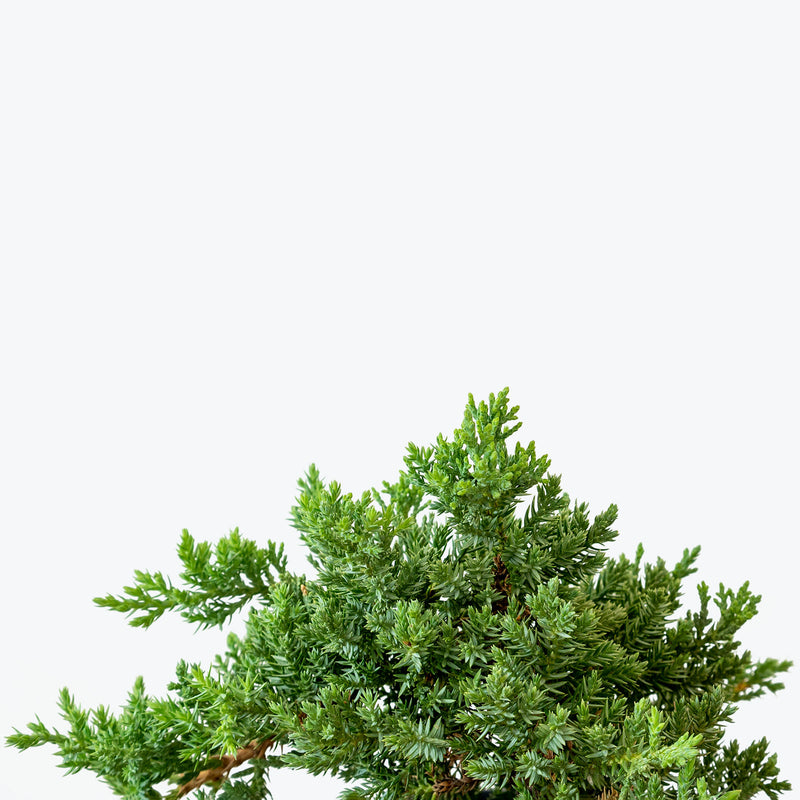
How to care for Juniper Bonsai
Juniper Bonsai enjoys some direct morning sun, but they'll also do well in bright, indirect light. It is best to place this plant somewhere where it will receive some nice morning sun and then bright indirect light the rest of the day.
Juniper Bonsai will do best in bright light. A nice bright place inside your home would be on the window sill or a stool that is right next to a window, either with or without blinds, depending on if the plant can handle sun. Remember that plants will grow based on how much light they receive.
Allow the top quarter of the soil to dry before watering Juniper Bonsai again. This usually takes about 3 - 4 days in an average home environment. It will vary depending on the time of year, your environment and lighting conditions. Expect to water more often in brighter light and less often in lower light.
Juniper Bonsai likes a high humidity environment, give them a mist daily or as often as possible. Alternatively, you can put them around a humidifier. Although they won't die if they don't receive enough humidity, their leaves may have some dry, crunchy, or yellow edges.
Be careful not to water Juniper Bonsai too much, as their roots don't like soggy soil. Before you water, the soil should dry slightly. Misting the tree should be done regularly as well. This bonsai usually needs a dormancy period, so during the winter, when it is growing less, place it somewhere that is a little cooler and receives a little less light than it was receiving previously. Pruning is essential for shaping and maintaining the desired form, as well as encouraging denser foliage growth. Repotting every two to three years in early spring is recommended to refresh the soil and manage root growth.
Juniper Bonsai is moderately toxic and can cause some adverse reactions when ingested so it is best to not let your pets eat it, which we advise for all plants in general. The severity of the reaction will depend on how much of the plant is ingested but, if you know your pet typically does not eat your plants, this plant will be suitable for your home..
Learn MoreView Plant



